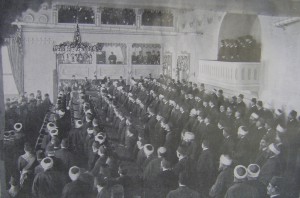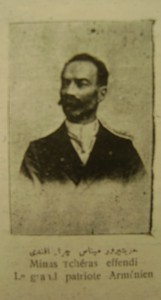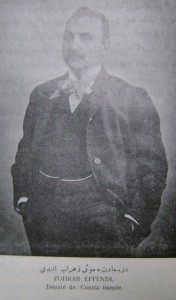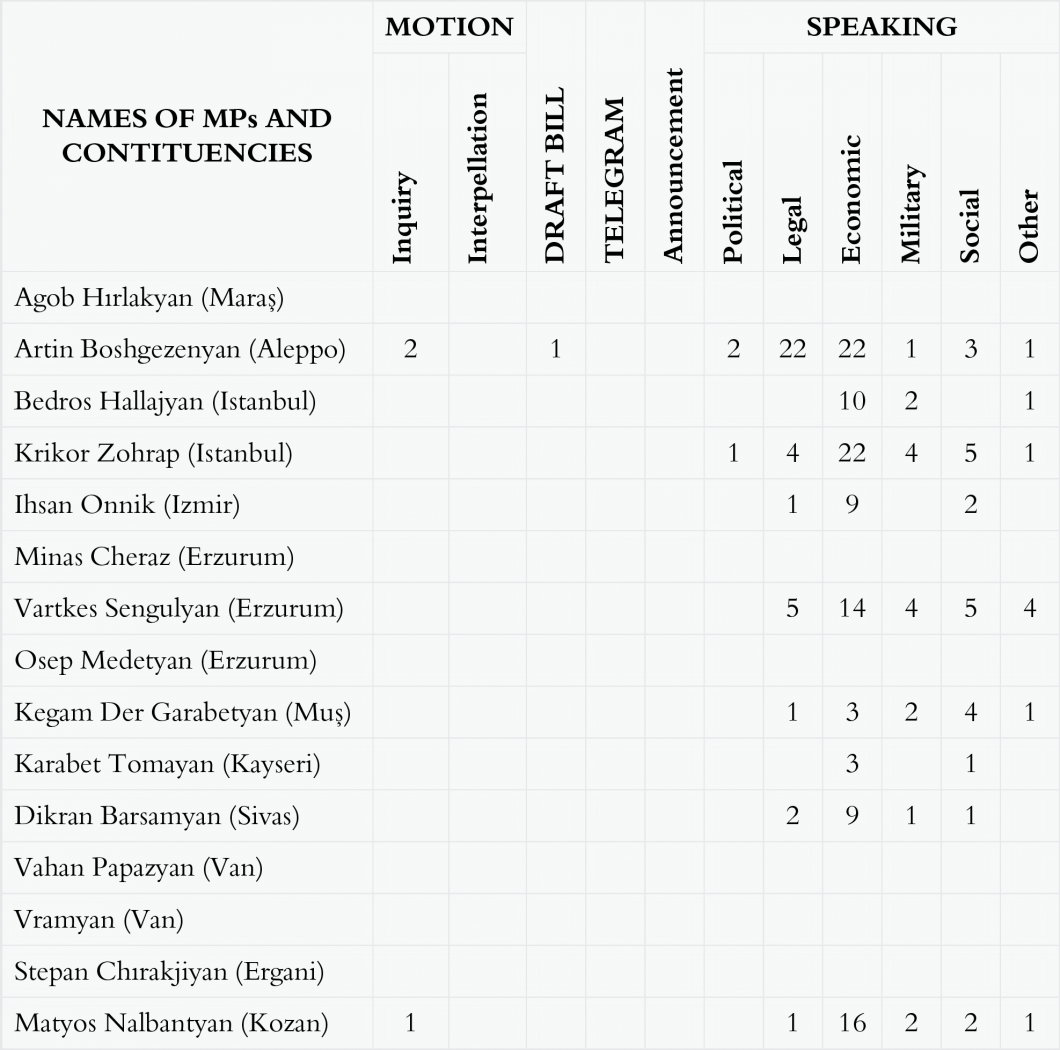Armenians in the 1914 Parliamentary Elections
The 2nd period Parliament that had started to work on 18 April 1912 was dissolved on 5 August 1912. According to the constitution, elections had to be held and the Parliament had to be opened within six months at the latest (Gözübüyük-Kili, 1982, p.36). Therefore, the government took the decision for elections, in some places secondary electorates and MPs were elected in some shires. However, the elections were postponed until a second decision after the start of the Balkan War. The war resulted in a big defeat for the Ottoman State, the social support that had been given to the Committee of Union and Progress (CUP), which had established the one party regime with the Babiali Raid, took a big hit. The victory achieved by the Balkan states strengthened the nationalist reflex of non-Turkish and non-Muslim elelements in the Ottoman State. In such an environment, the government took the decision to hold the 17 October 1913 elections. However, it kept its compromising attitude because of the reform projects of the Great Powers and because it aimed at preventing the Armenian demands turning into a foreign problem within the framework of the ideology of Ottomanism. This is because it needed the support of the Armenians. The Armenian community and political organizations, which had displayed a fragmented structure in the 1908 and 1912 elections, united under the roof of the Patriarchate this time.
A commission was formed of the Armenian and Armenian Catholic millats (communities) and the representatives of the Armenian political organizations, which were led by Tashnaksutyun, Social Democrat Hinchak, and Ramgavar. The commission requested an ethnic proportional representation system to be used in elections via a memorandum that it submitted to the Minister of Justice, Ibrahim Bey. In addition, it requested an arrangement by which the Armenians would have at least 20 MPs in the Parliament. The proposed arrangement required the Armenian MPs to be elected by the Armenians because in the 1912 elections, the local Armenian representatives and the Tashnaksutyun Association wanted Simbat Kaniban to be elected as an MP, but (H)Agob Boyaciyan, who was another Armenian supported by the CUP, won the election. This attitude, which was deemed “inappropriate” by the Armenians, was displayed elsewhere as well. Therefore, there was an objection to the Armenian candidates being selected by the members of the CUP.
Faced with this attitude of the two major powers that represented the Armenians in the Ottoman country, namely the Patriarchate and the Tashnaksutyun Association, the Union and Progress adopted a determined but soft approach. Minister of Interior, Talat Bey, repeated once again in a meeting he held with the Patriarch, Zaven Effendi, that the Armenians would be satisfied. When the Minister of Justice visited the Patriarchate, he indicated that a compromise would be reached by the government about the number of Armenian MPs, but that the proposal for changing the electoral law would never be accepted. The positive attitude of the government was also felt at the return visit that Zaven Effendi made to the government offices of the Grand Vizier. Talat Bey stated that an effort would be made to select the candidates nominated by the Armenians and that 20 MPs could be elected and 3 of those would be selected by the CUP. Meanwhile, the Armenian political organizations, which had some differences of opinion, decided to act together in the national and political fields after a series of meetings that they held. On behalf of the Armenians, Artin Shahirbekyan, Hamparsum Boyaciyan, and Diran Yorganyan carried out the discussions that were held with Talat Bey. At the meetings, the subject of the number of MPs and how they would be identified was discussed. When the government absolutely rejected the the demand to use proportional representation, the Armenians decided not to participate in the elections. A delegation that was composed of the representatives of the Armenian political organizations came. The delegation took the following decisions at the meeting it held on 9 February 1914:
- All of the Armenians who live in Turkey shall have 20 MPs in the Parliament in proportion to the population of the Armenians,
- The Armenian candidates for MPs shall be determined by the Armenians,
- The neighborhoods that will send MPs to the parliament shall be identified by the Armenians,
- The government shall promise to submit a “national election” draft bill to the parliament,
- The election procedures shall be delayed in those neghborhoods where an Armenian MP will be elected,
- Having the meetings in question through the election commission to be formed by the Patriarchate and with the Patriarch Effendi as the head of the commission after this and various similar requests are put into practice.
In line with the decision that were taken, the number of MPs that the Armenians demanded at the meeting held with the CUP became a problem. When the CUP indicated that 20 MPs could not be elected because the elections had advanced, the Armenians suggested the number 16. A compromise was reached whereby three MPs would be selected by the CUP and 13 MPs would be elected by the Armenians and a total of 16 MPS would represent the Armenians in the Ottoman Parliament. Three foci were effective in the election of the Ottoman MPs of Armenian origin in the 1913-1914 elections: 1- The Committee of Union and Progress, 2- The Patriarchate, and 3- The Armenian Political Organizations. The CUP selected the Istanbul candidates and the Aleppo candidate, it nominated Bedros Hallajyan and Kirkor Zohrab from among the former Istanbul MPs, and it nominated Artin Boshgezenyan from Aleppo to be MPs. The Armenian General Assembly approved these candidates.
Some troubles were experienced in determining the MP candidates who would be elected from outside of Istanbul. The election commission that gathered under the head role of the Patriarch Zaven Effendi discussed the nominations of Minas Cheraz (Kiraz Effendi) from Bitlis, Diran Kilikyan from Kayseri, and Professor Tomayan. Kilikyan was removed from the list because he was a member of a political party. A decision was taken to nominate Matyos Nalbantyan from the Kozan Armenian Protestant community instead of Hamparsum Boyaciyan, who was a member of Hinchak. The Patriarchate wanted to nominate Vahan Papazyan from Van and Vramyan from Muş, but it omitted them from the list because they were Tashnaksutyun members. It decided to consult the Van and Muş Armenian representatives about who to nominate from these two regions. While the work to identify the candidates was going on at the Patriarchate, the local Armenian ortanizations also applied to the Patriarchate with some of their suggestions regarding the candidates. Within this framework, a delegation representing the Amasya Armeinan community visited Patriarch Zaven Effendi on 19 February and requested Professor Tomayan to be elected as an MP and his nomination was approved by the Patriarchate. The Bitlis Armenian representative office wanted the nomination of Tashnak Armanak Hachikyan as opposed to Hinchak Minas, who was the candidate of the Patriarchate. The Erzurum Armenian representative office sent a telegram to the Patriarchate and in that telegram, it indicated that it had nominated Vartkes (Serengulyan) and Karakin Pastirmajiyan (Armen Garo) and that they would cut off all of their ties with the Patriarchate if these two people were not nominated. Both names were Tashnak. At the same time as this telegram, which smelled of a threat, Tashnaksutyun also tried to make propaganda indicating that the Armenians in Anatolia should not participate in the elections. Agob Papazyan from Manisa indicated these threats with a telegram he sent to the Patriarchate. Pastirmajiyan, who was the candidate that was nominated by the Tashnaks in Van, stated in a telegram he sent to Zaven Effendi that he was the candidate that the Erzurum Armenians wanted and that he would not accept nomination from a place other than Erzurum.
The Armenian political organizations, having disagreement among themselves, the inability to deliver the news on the compromise between the Patriarchate and the government to those constituencies outside of Istanbul, and the inability to determine the Armenian MP candidate in any way at all, had a negative impact on the Armenian electorate. The parliamentary elections started in the whole of the country in mid-February 1914. 467 secondary voters went to the ballots on 28 February to elect the 11 MPs who would be elected from Istanbul. Bedros Hallajyan and Krikor Zohrab were among the MPs who were elected. The MPs of the Izmir sanjak, which was linked to the province of Aydin, were elected in the first days of March and Ihsan Onnik was elected as an MP. 47 secondary voters voted in Ergani mine, which was a sanjak linked with the province of Diyarbakir, and Stepan Chirajiyan was elected with 46 votes. Dikran Barsamyan, who was a Dar al-funun English teacher, was elected as MP in Sivas in the elections that were held on 3 March.
95 MPs who were going to be in the Parliament were identified after 9 March. As for the Armenian MPs, five of them were known: Bedros Hallajyan and Krikor Zohrap from Istanbul, Ihsan Onnik from Izmir, Stepan Chirakchiyan from Ergani, and Dikran Barsamyan from the central sanjak of the province of Sivas. The elections were completed in the second half of March in Kayseri; Professor Karabet Tomayan was elected as an MP. Matyos Nalbantyan, who was the candidate of the Patriarchate, was elected in the Kozan sanjak of the province of Adana, and Artin Boshgezenyan, who was the candidate of the CUP supporters, was elected from Aleppo. The MPs of Muş, Bitlis, and Maraş were elected in April. Kegham Der Garabetyan (Dadrag-Asoghig) was elected as an MP with a majority vote in Muş; Minas Cheraz (Kiraz Effendi), who was the candidate of the Patriarchate, was elected from Bitlis; and (H)Agop Hirlikyan was elected from Maraş. The MPs for Erzurum and Van could only be determined after the parliament opened. Vartkes Serengulyan (Hovhannes) was elected in Erzurum with 154 votes and Oseb Medetyan became an MP with 128 votes; but what attracted attention, was that Karakin Pastirmajiyan (Armen garo) could not be elected. Vramyan and Vahan Papazyan (Goms) were elected in Van. Therefore, 15 Armenian MPs served in the 3rd period Parliament. This number was one short of the one promised by the CUP to the Armenians.
Five of the MPs who were elected for the 1914 Parliament, namely Hallajyan, Zohrab, Der Garabetyan, Boshgezenyan, and Serengulyan, served as MPs in all three periods. Chirakjiyan and Vramyan served as MPs in the 2nd period and Papazyan served as MP in the 1st period. Seven MPs, namely Tomayan, Cheraz, Medetyan, Hirlakyan, Barsamyan, Nalbantyan and İhsan Onnik, became MPs for the first time during the 2nd Constitutional period.
The 3rd Parliament of the 2nd Constitutional Period opened on 14 May 1914 after an interval of twenty-one months. The work of this Parliament, which was also a War Parliament, started with a period of an extraordinary meeting. Ten Armenian MPs were present at the opening of the Parliament, namely Stepan Chirakjiyan, Onnik Ihsan, Bedros Hallajyan, Krikor Zohrap, Dikran Barsamyan, Matyos Nalbantyan, Karabet Tomayan, Agop Hirlakyan, Kegham Der Garabetyan, and Artin Boshgezenyan. They took the oath on the same day. The election records of eight MPs came to the Parliament on 18 May. The election as an MP was approved for the following people: Stepan Chirakjiyan, Ihsan Onnik, Artin Boshgezenyan, Dikran Barsamyan, Matyos Nalbantyan, Karabet Tomayan, Agop Hirlakyan, and Kegham Der Garabetyan. The election record of Bedros Hallajyan, who was elected as an MP for Istanbul, was read and accepted on 19 May and the election record of Krikor Zohrap was read and accepted on 27 May. On the same day, that is on 27 May, Vartkes, who was elected as an MP for Erzurum, joined the Parliament and took the oath. The election record of Vartkes was read and accepted on 1 June, that of Osep Medetyan was read and accepted on 6 June, the election records of Vahan Papazyan and Vramyan, who were MPs for Van, were only read and accepted on 24 December 1914. When their election as MPs was approved, the last two that were mentioned were not in the Parliament. Papazyan’s request for leave due to the weather conditions caused some reactions when it was mentioned on 28 December. It was asked how his excuse could be accepted when even the Muş MPs had come. Despite the defense by Vartkes, the request for leave that was sent to the committee was only approved on 20 January 1915. Vramyan had requested a leave indicating that his voters wanted him to act as an intermediary between the government and the Armenian nation because of the incidents that emerged in Van and its vicinity. Upon this request, Vartkes took the floor and pointed out that the reasons that required Vramyan to be present in Van required him to be in Muş. He stated that their pupose was to serve the state, nation, and Ottomanism. Papazyan’s request was also accepted.
Vramyan and Papazyan, who were from among the Tashnak leaders, did not attend the parliamentary sessions again. Minas Cheraz, who was elected from Bitlis as the candidate of the Patriarchate for the 1914 Parliament, did not attend any session including the opening. The presence of Stpan Chirakjiyan, who was an MP for Ergani, and Osep Medetyan, who was an MP for Erzurum, remained limited to the votes they cast for some draft bills. Only Vramyan form among the Van MPs attended the voting for two draft bills. Neither Vramyan, nor Papazyan addressed the Parliament. The insufficiency of his Turkish was influential in Papazyan not speaking in the Parliament (Minassian, 2005, 163). On the other hand, Artin Boshgezenyan, Krikor Zohrap and Vartkes Serengulyan were among the most active members of the Parliament in 1914. The Armenian MPs, who took the floor mostly in economic and legal subjects, also indicated the requirements of their constiutencies in the military and social areas.
Table: Activities of the Armenian MPs in the 1914 Parliament
When the Ottoman State entered the the First World War on 1 November 1914 and issued an order for mobilization, the Van Tashnak administration, where Vramyan and Papazyan were also leaders, did not approve of Armenian youths to be enlisted in the army. On 17 April 1915, Vramyan, who went to the office of Jawdat Bey, who was the governor of Van, to obtain information about the murder of Ishkan, who was one of the Tashnak local administrators, and his three friends on 16 April 1915, was arrested (Minassian, 2005, 205-206). As for Papazyan, he joined the Armenian batallions in Russia.
The Head Office of the Parliament applied to the government headquarters with regards to the absence of the Armenian MPs from the Parliament and it requested information on this. According to a letter by the Grand Vizier’s office dated 28 november 1916, Vramyan “perished” near Bitlis during the Van Rebellion (April 1915). As for Papazyan, he joined the gangs in Muş and he “was killed” while commanding them. Only one voice rose from the Parliament in relation to the way Vramyan and Papazyan died. Mamuretulaziz MP Mehmed Said Effendi approved their end saying “may they get their punishment.” The Speaker of the Parliament summarized his fury saying “of course it must not be a good end for an MP.” Again, according to the letter of the office of the Grand Vizier, Erzurum MP Vartkes and Istanbul MP Zohrap were killed by the members of the Circassian Ahmed and his gang while they were on their way to Diyarbakir and their murderers were tried by the Extraordinary Court-Martial in Damascus and then executed. In addition, it was indicated that Ergani MP Stepan Chirakjiyan died and Kayseri MP Tomayan had left the country before the year of assembly in 1915 and that he had never returned. Minas Cheraz, who was mentined as “Kiraz Effendi” in the Turkish sources, went to Europe before the mobilizaiton and did not return again. On 11 December 1916, the members of the Parliament took a decision for filling the seats that were emptied because of the absence of Cheraz, Zohrab, Vartkes, Papazyan, Vramyan, Stepan, and Tomayan. However, none of the MPs that were elected for their seats were Armenian.
Therefore, the Armenians, who started to carry out legislative work in 1914 with 15 MPs were represented in the Ottoman Parliament with 8 MPs until 1918 and these 8 MPs were the following: Onnik Ihsan, Bedros Hallajyan, Dikran Barsamyan, Matyos Nalbantyan, Agop Hirlakyan, Kegham Der Garabetyan, Artin Boshgezenyan, and Osep Medetyan.
Bibliography
Tanin, 29 October 1913-14 May 1914.
Meclis-i Mebusan Zabıt Ceridesi (MMZC), (Parliamentary Records Newspaper), 14 May 1914-11 December 1916).
Ahmad, Feroz. “İttihatçıların, Osmanlı İmparatorluğu’ndaki Rum, Ermeni ve Yahudi Cemaatleriyle Olan İlişkileri 1908-1914”, İttihatçılıktan Kemalizme, Çev. Fatmagül Berktay Baltalı, İstanbul: Kaynak Yayınları 1996, s. 121.
Ahmad, Feroz ve Rustow, Dankward A. “İkinci Meşrutiyet Döneminde Meclisler: 1908-1918”, Güney-Doğu Avrupa Araştırmaları Dergisi 4-5, İstanbul Üniversitesi Edebiyat Fakültesi Basımevi, 1976, s. 266-284.
Altınay, Ahmet Refik, İki Komite İki Kıtâl Kafkas Yollarında, İstanbul: Tarih Vakfı Yurt Yayınları, 2010, s. 40-43.
Gözübüyük, Şeref ve Kili, Suna. Türk Anayasa Metinleri, Ankara: 1982, s. 36.
İzrail, Nesim Ovadya. 1915 Bir Ölüm Yolculuğu Krikor Zohrab, İstanbul: Pencere Yayınları, 2013.
Minassian, Gaidz. F. “Birinci Dünya Savaşı Öncesinde İttihat ve Terakki Cemiyeti ile Ermeni Devrimci Federasyonu Arasındaki İlişkiler,” Çev. Mutlucan Şahan, Ermeniler ve İttihat ve Terakki İşbirliğinden Çatışmaya, İstanbul: Aras Yayınları, 2005, s. 163.
Categories
- Experience of Living Together of Turks and Armenians
- Demographic Structure of Armenians in the Ottoman Lands
- Disturbances in Anatolia: Protests and Anarchy
- Armenians and the International System: Seeking a Solution
- Historiography in Turkish-Armenian Relations
- Dispatchment and Settlement: Discourses of Genocide
- Trials and International Law
- Armenians in Society and Bureaucracy
- Armenian Diaspora
- Church, Identity, and Social Structure




